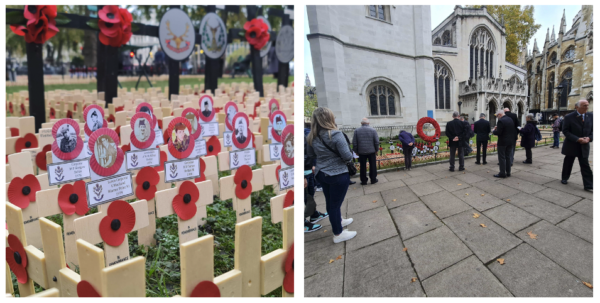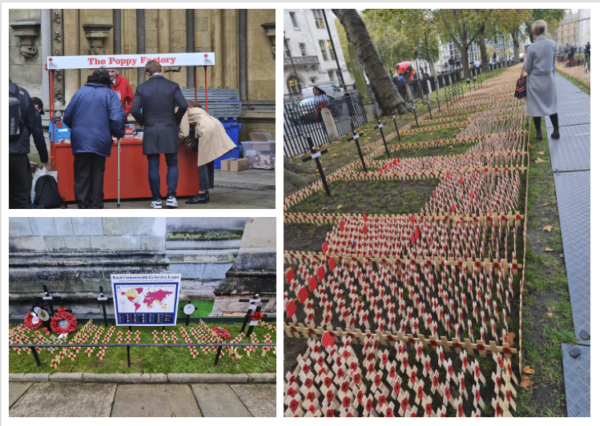On the 11th hour of the 11th day of the 11th month people all over the UK and the Commonwealth observe two minutes’ silence to mark the day the armistice was signed between the Allies and Germany ending World War 1.
Initially called Armistice Day, the day is now widely known as Remembrance Day across the UK and Commonwealth and Memorial or Veterans Day in other countries. The first official Armistice Day events were held in the grounds of Buckinham Palace on the morning of 11 November 1919, and in 1921 The Royal British Legion began the Poppy Appeal.
So the day I visted the Field of Remembrance in Westminster to witness this year’s Remembrance Day ceremonies was 100 years to the day since poppies were first worn as a symbol of remebrance for the dead.
The Duchess of Cornwall joined military veterans at Westminster Abbey to open the ceremony, observe two minutes silence and lay a cross amid the poppies.
Just before the “exhortation to remembrance” was said, The Last Post was played by a bandsman from the Scots Guards high up in the roof of the Abbey. The two-minute silence was led by the Dean of Westminster, the Very Reverend Dr. David Hoyle, and was ended by the bands playing the Reveille.
The Duchess then went on to greet military veterans and toured some of the plots in the grounds of the Abbey while I took photographs of the Field of Remembrance and the many thousands of wooden crosses planted in the ground.
Remembrance Day
Remembrance Day is traditionally held to honour those from all faiths, cultures and backgrounds died in the line of duty. A prominent symbol of the day is the Remembrance Poppy, a flower associated with the fields in Belgium where poppies grew amongst the graves, and with the poem below written by Lieutenant-Colonial John McCrae on May 3rd 1915 after the funeral of a friend.
In Flanders fields the poppies blow
Between the crosses, row on row,
That mark our place; and in the sky
The larks, still bravely singing, fly
Scarce heard amid the guns below.
We are the dead. Short days ago
We lived, felt dawn, saw sunset glow,
Loved, and were loved, and now we lie
In Flanders fields.
Take up our quarrel with the foe:
To you from failing hands we throw
The torch; be yours to hold it high.
If ye break faith with us who die
We shall not sleep, though poppies grow
In Flanders fields.
Poppy Day & Royal British Legion
This year marks 100 years since the first poppy appeal was run by the Royal British Legion, founded in 1921 to support members and veterans of the British Armed Forces and their families. The legion adopted the poppy as a ‘symbol of both remembrance and hope for a peaceful future’. In 1921 the Legion distributed nine million poppies and raised over £100,000, and since then its activities have extended into other initiatives such as the Poppy Shop, My Poppy Run and the 11/11 Challenge.
The Field of Remembrance in Westminster
On the lawn of St Margaret’s Church, Westminster, between Westminster Abbey and the House of Parliament, is a memorial garden called The Field of Remembrance, which was first established by The Poppy Factory in 1928.
Marked out on the lawn are 250 plots for regimental and armed services associations. Participants can purchase a wooden token of remembrance decorated with a remembrance poppy which generally carries a tribute/message to someone who lost their life in service for British and Commonwealth nations. This is then planted in the appropriate plot. There are five other fields of remembrance spread around the UK.





